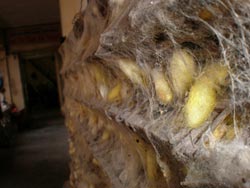Saving silkworms: current approaches to combat Microsporidiosis

Copyright : denthewise<br>
Microsporidiosis is a disease caused by highly infective parasitic microsporidian. The spores of microsporidian, known as pebrine, infect almost all ages, stages, breeds and hybrids of silkworms. A recent publication by Singh and colleagues in the Pertanika Journal of Tropical Agricultural Science explores a range of methods to combat this disease – a key task that determines the future of the sericulture industry.
The disease is primarily transmitted to silkworm eggs within the body of the infected mother moth, but also externally, for example by rearing healthy silkworms with infected larvae. Infections could lead to loss to the sericulture industry and causes instability to the volume of silk outputs. Efforts have been made to eliminate pebrine but so far with limited success. In order to help save silk production, the authors reviewed recent studies presenting different aspects of pebrine.
Previous research has identified various approaches to save silkworms. One of the most effective methods, according to the authors, is based on the selection of pathogen-free eggs through a systematic examination of the mother moths after laying eggs. Recently, microscopic test using mother moths was introduced as an easy and accurate diagnosing technique.
Furthermore, a three-tier examination approach (larval, pupal and moth) is used for disease management. Thermal treatment, sterilization and monoclonal antibody technique also help minimize pebrine infections.
The disease is becoming increasingly complex because of increasing number of different types of microsporidian infecting silkworms. Currently there is no one technique that is able to quickly identify the type of parasite involved which makes it more difficult for silkworm breeders to take appropriate action. While the methods described here are used to prevent pebrine, finding a more effective, all-round approach remains the task for future research.
For more information on the research, contact:
Singh, T.
Regional Sericultural Research Station
Research Extension Centre
Central Silk Board, Ministry of Textiles
Govt. of India
Rampur Road
Una 174 303, Himachal Pradesh, India.
E-mail: tnspriya@yahoo.com
Tel: + (91) 1975-227995; Mobile: + (91) 9805 207 088.
About Pertanika Journal of Tropical Agricultural Science (JTAS)
Pertanika Journal of Tropical Agricultural Science (JTAS) is published by Universiti Putra Malaysia in English and is open to authors around the world regardless of nationality. It currently publishes four times a year in February, May, August and November. Other Pertanika series include Pertanika Journal of Science & Technology (JST), and Pertanika Journal of Social Sciences & Humanities (JSSH).
JTAS aims to provide a forum for high quality research related to tropical agricultural research. Areas relevant to the scope of the journal include: agricultural biotechnology, biochemistry, biology, ecology, fisheries, forestry, food sciences, entomology, genetics, microbiology, pathology and management, physiology, plant and animal sciences, production of plants and animals of economic importance, and veterinary medicine. The journal publishes original academic articles dealing with research on issues of worldwide relevance.
For more information about the journal, contact:
The Chief Executive Editor
Journal Division
Office of the Deputy Vice Chancellor (R&I)
IDEA Tower 2, UPM-MDTC Technology Centre
Universiti Putra Malaysia
43400 Serdang, Selangor
Malaysia.
Phone: + (603) 8947 1622 | + (6) 016 217 4050
Email: nayan@upm.my
**
Date of Release: 4 December, 2012
Acknowledgements
The Chief Executive Editor, UPM Journals
Journal information
Singh, T.*, Bhat, M. M. and Khan, M. A.(2012) Microsporidiosis in the Silkworm, Bombyx mori L. (Lepidoptera: Bombycidae). Pertanika Journal of Tropical Agricultural Sciences 35 (3): 387-406.
Media Contact
All latest news from the category: Life Sciences and Chemistry
Articles and reports from the Life Sciences and chemistry area deal with applied and basic research into modern biology, chemistry and human medicine.
Valuable information can be found on a range of life sciences fields including bacteriology, biochemistry, bionics, bioinformatics, biophysics, biotechnology, genetics, geobotany, human biology, marine biology, microbiology, molecular biology, cellular biology, zoology, bioinorganic chemistry, microchemistry and environmental chemistry.
Newest articles

Superradiant atoms could push the boundaries of how precisely time can be measured
Superradiant atoms can help us measure time more precisely than ever. In a new study, researchers from the University of Copenhagen present a new method for measuring the time interval,…

Ion thermoelectric conversion devices for near room temperature
The electrode sheet of the thermoelectric device consists of ionic hydrogel, which is sandwiched between the electrodes to form, and the Prussian blue on the electrode undergoes a redox reaction…

Zap Energy achieves 37-million-degree temperatures in a compact device
New publication reports record electron temperatures for a small-scale, sheared-flow-stabilized Z-pinch fusion device. In the nine decades since humans first produced fusion reactions, only a few fusion technologies have demonstrated…





















